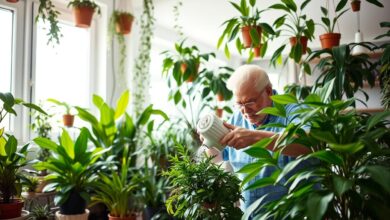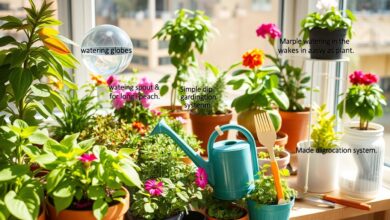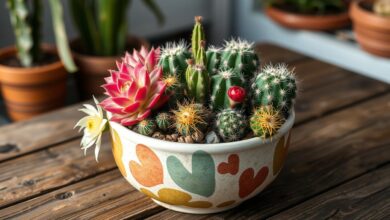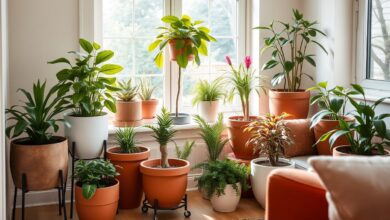Low-Maintenance Plants for Senior Living Spaces
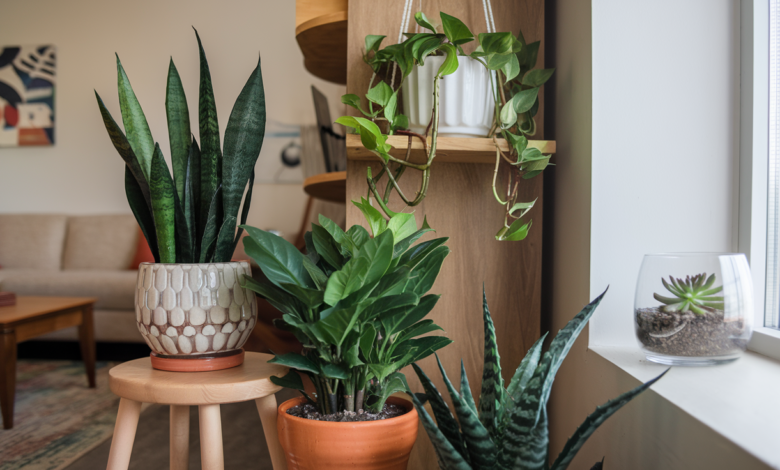
Discover the perfect low-maintenance plants for senior living spaces. Enhance your environment with easy-care plants for senior homes that bring joy and improve air quality. This comprehensive guide will explore a variety of hardy, resilient, and visually appealing plants that thrive with minimal care, making them ideal for seniors and assisted living communities.
Key Takeaways
- Outdoor spaces have become increasingly important for seniors, providing relaxation and health benefits.
- Combining flowering and non-flowering plants can create visually appealing environments for diverse preferences.
- Low-maintenance plants like Lavender, Coneflowers, Hostas, and Succulents are ideal for senior living spaces.
- Practical tips on plant placement and maintenance, including sunlight, soil, watering, and pest control.
- Incorporating low-maintenance plants enhances the beauty and well-being of seniors and their families.
Introduction to Easy-Care Plants for Senior Homes
Incorporating senior living greenery into retirement homes and assisted living communities offers a wealth of benefits for the elderly. From enhancing mental well-being to improving indoor air quality, the presence of resilient foliage for elderly can profoundly impact the quality of life for senior residents. However, seniors may face unique challenges in maintaining retirement home botanicals, such as limited mobility, inconsistent watering schedules, and low-light conditions. In this section, we’ll explore the advantages of easy-care plants and address the common obstacles seniors encounter when caring for sustainable indoor gardens.
Benefits of Incorporating Plants into Senior Living Environments
A growing body of research suggests that exposure to plants can have a positive effect on the mental and physical well-being of seniors. Studies have shown that indoor plants can reduce cold-related illnesses by more than 30% and help purify the air by removing up to 60% of airborne molds and bacteria. Additionally, plants can serve as mood enhancers, with fragrant varieties like lavender and jasmine offering calming and uplifting properties for senior residents.
Challenges Faced by Seniors in Maintaining Plants
- Limited mobility and dexterity can make it difficult for seniors to water, prune, and maintain plants on a regular basis.
- Inconsistent watering schedules due to memory lapses or changes in routine can lead to over- or under-watering of plants.
- Low-light conditions common in senior living facilities can be a challenge for certain plant species, requiring careful selection of resilient, low-maintenance options.
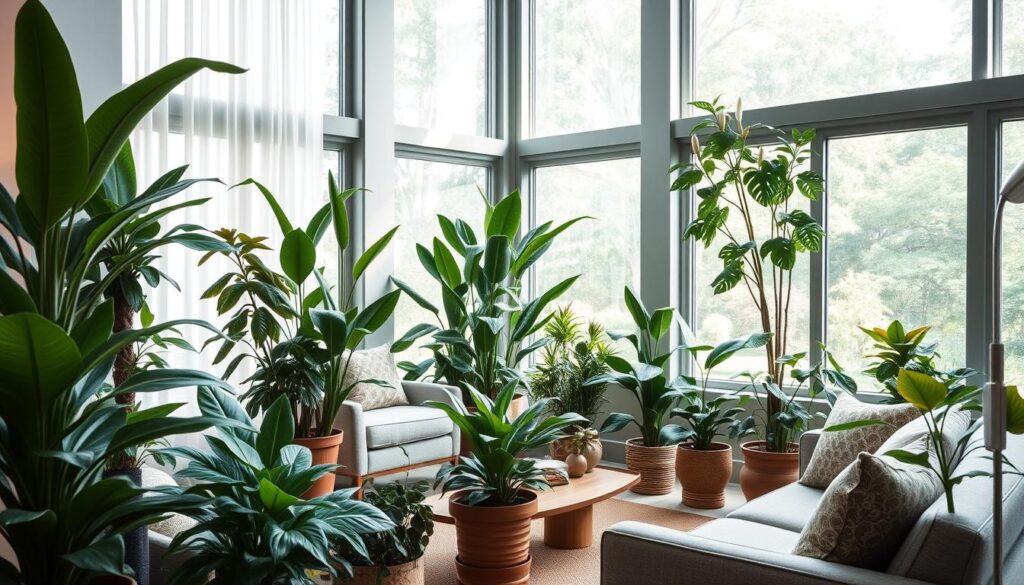
By understanding the unique needs and constraints faced by seniors, we can curate a selection of easy-care plants that thrive in senior living environments, ensuring a lush and vibrant sustainable indoor garden for all to enjoy.
Pothos: The Undemanding Trailing Plant
When it comes to low-maintenance houseplants perfect for senior living spaces, the Pothos plant stands out as a true champion. This hardy indoor flora for aging adults thrives in low-light conditions and can tolerate both over and under-watering, making it an ideal choice for those seeking durable greenery for assisted living environments.
Adaptability to Low-Light Conditions
One of the key benefits of the Pothos plant is its remarkable ability to adapt to a wide range of lighting conditions. With its trailing vines and lush heart-shaped leaves, Pothos can flourish in both bright and low-light settings, making it a versatile option for various senior living spaces. This adaptability ensures that Pothos can thrive even in areas with limited natural light, providing a touch of greenery without demanding high-maintenance care.
Tolerance for Over/Under Watering
Another notable feature of the Pothos plant is its tolerance for both over and under-watering. Unlike many other houseplants, Pothos can bounce back from occasional watering mishaps, making it an excellent choice for seniors who may occasionally forget to water their plants. This resilience helps to ensure that the Pothos remains a low-maintenance and hardy indoor flora for aging adults, thriving even in the face of minor watering irregularities.
The Pothos plant’s adaptability and resilience make it a fantastic addition to any senior living space, providing a touch of durable greenery that requires minimal care and attention. Whether in a sunny corner or a dimly lit area, this trailing plant’s ability to purify the air and bring a sense of life to the environment makes it a natural choice for those seeking low-maintenance houseplants to enhance their living spaces.
Aglaonema (Chinese Evergreen): A Versatile Foliage Plant
For senior living spaces, the Aglaonema, also known as the Chinese Evergreen, is an excellent choice. This low-maintenance hardy indoor flora for aging adults can thrive in a wide range of conditions, including low-light levels and inconsistent watering schedules. Its lush, durable greenery for assisted living makes it a versatile option for enhancing the ambiance of senior living environments.
Aglaonema “Silver Bay” can grow up to around 4 feet tall, with leaves that range from 9 to 12 inches long. These low-maintenance houseplants can adapt to bright, medium, or low indirect light, making them ideal for a variety of living spaces. They prefer temperatures between 60-85 degrees Fahrenheit, making them comfortable companions in senior homes.
One of the key benefits of Aglaonema is its resilience against common pests. Vigilance is needed to watch for mealybugs, scales, spider mites, and aphids, but these plants can often recover with proper care. By understanding the signs of these potential issues, seniors and their caregivers can keep the Chinese Evergreen thriving.
“Aglaonema species are native to humid and shady tropical forests in Asia. These plants are known for being among the best houseplants for low light conditions indoors.”
Aglaonema can thrive in front of a Northern exposure window or an Eastern exposure window (morning sun) inside a home. They can also do well a few feet away from a window and even in office settings with fluorescent lighting but no windows. With their adaptability to various lighting conditions, Aglaonema makes an excellent choice for senior living spaces.
Proper care for Aglaonema includes using a well-draining soil mix, thorough watering, and occasional fertilization during the active growing season. By providing the right environment, seniors and their caregivers can enjoy the lush, low-maintenance houseplants that Aglaonema offers.
Ponytail Palm: A Statement Plant for Sunny Spaces
For senior living spaces with access to sunny windows, the Ponytail Palm is a visually striking and low-maintenance option. This plant’s unique appearance and drought-tolerant nature make it well-suited for easy-care plants for senior homes and long-lasting plants for care facilities, adding a touch of durable greenery to assisted living spaces.
Unique Appearance and Drought Tolerance
The Ponytail Palm, classified in the Asparagaceae family and Nolinoideae subfamily, is known for its distinctive bulbous base, strap-like foliage, and slow growth. In their native habitats, these palms can reach up to 30 feet tall, but they typically remain smaller when grown indoors. Ponytail palms have become increasingly popular in bonsai arrangements, as they can thrive when grown full-time in indoor conditions, unlike many other bonsai species.
Ponytail palms are hardy and tolerant, making them a popular choice for senior living environments. They are particularly well-suited for sunny, dry, and warm conditions, thriving in south-facing rooms that provide the brightest and most intense daylight during the Spring and Summer months. With their drought-tolerant nature, Ponytail palms require minimal watering, making them an easy-care and long-lasting plant option for care facilities and assisted living spaces.
Care Tips for Ponytail Palms
To ensure the successful growth of Ponytail palms in senior living environments, it’s essential to follow a few care tips:
- Provide the plant with plenty of sunlight, ideally in a south-facing room.
- Water the Ponytail palm sparingly, allowing the soil to dry out between waterings.
- Monitor for common houseplant pests like aphids and address any issues promptly.
- Prune and shape the plant as needed to maintain its desired appearance.
- Fertilize the Ponytail palm occasionally to support its slow but steady growth.
With their unique appearance, drought tolerance, and relatively low maintenance requirements, Ponytail palms can be a great addition to senior living spaces, providing a touch of durable greenery and visual interest to these environments.
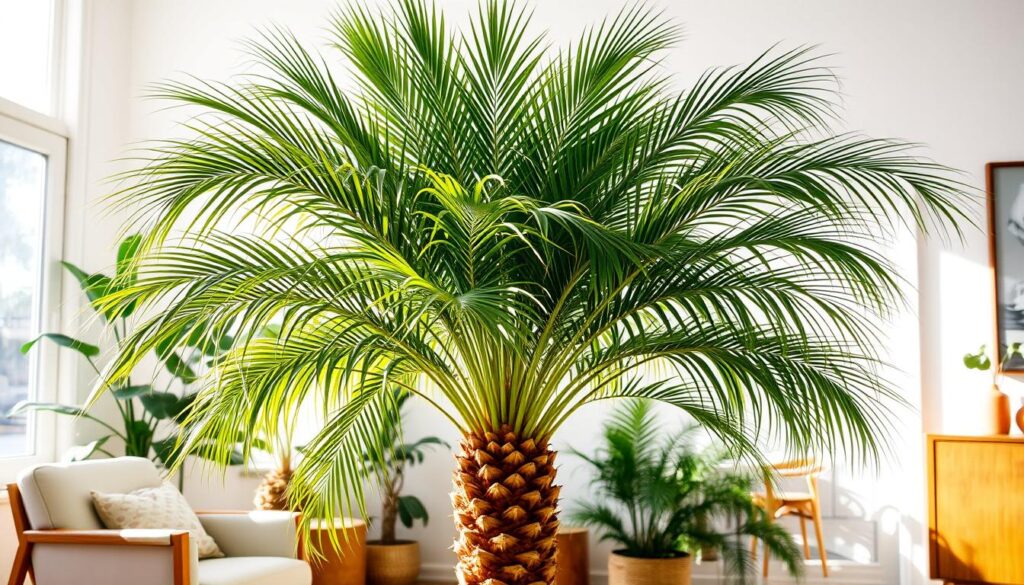
Jade Plant: A Succulent Gem
For seniors seeking low-maintenance houseplants that thrive in assisted living environments, the Jade plant (Crassula ovata) stands out as a true gem. This hardy, succulent species originates from the dry, rocky hillsides of southern Africa and is renowned for its ability to store water in its bulbous leaves, making it an ideal choice for low-maintenance houseplants, hardy indoor flora for aging adults, and durable greenery for assisted living.
Water Storage Capabilities
The Jade plant’s remarkable water storage capabilities allow it to tolerate periods of drought and neglect, a common challenge faced by seniors in maintaining plants. By employing Crassulacean acid metabolism (CAM) photosynthesis, the Jade plant can conserve water, thriving even when watering schedules are irregular or infrequent.
Growth Habits and Sunlight Requirements
In addition to its water-wise nature, the Jade plant’s growth habits and sunlight requirements make it a versatile choice for senior living environments. The plant can adapt to a variety of lighting conditions, from deep shade to full sun, allowing it to thrive in a wide range of settings. As the Jade plant matures, it can grow up to 6 feet tall, making it a statement piece that adds visual interest to any space.
With its unique appearance, water-storage capabilities, and adaptability to various light conditions, the Jade plant is an excellent choice for seniors seeking low-maintenance houseplants, hardy indoor flora for aging adults, and durable greenery for assisted living. Its resilience and versatility make it an ideal addition to any senior living environment.
| Jade Plant Features | Details |
|---|---|
| Water Storage | Able to tolerate periods of drought and neglect due to water storage in bulbous leaves |
| Light Requirements | Thrives in a variety of lighting conditions, from deep shade to full sun |
| Growth Habits | Can grow up to 6 feet tall, making it a striking addition to any space |
| Propagation | Easily propagated through fallen leaves or broken branches |
| Longevity | Known for its remarkable longevity, equaling a human lifespan |
Spider Plant: A Low-Light Favorite
For senior living spaces, the Spider plant stands out as an excellent choice. This resilient and low-maintenance houseplant thrives in low-light conditions, making it an ideal addition to assisted living environments. Known for its cascading leaves and easy-care nature, the Spider plant is a popular pick for enhancing the ambiance of senior living communities.
One of the most widely cultivated houseplants, the Spider plant is renowned for its adaptability and tolerance to various growing conditions. With a moderate to fast growth rate, this hardy indoor flora for aging adults can quickly fill a space with its vibrant greenery, providing a touch of nature to durable greenery for assisted living settings.
- Spider Plants are one of the most popular houseplants in the world and one of the easiest indoor plants to care for.
- Depending on growing conditions, Spider Plants have a moderate to fast growth rate.
- Spider Plants prefer bright, indirect light but can tolerate lower light conditions, making them a low-maintenance houseplant option.
- The watering frequency for Spider Plants can vary from every 10-21 days, depending on factors such as pot size, soil type, and environmental conditions.
With their ability to thrive in a variety of lighting conditions and their resilience to over or under-watering, Spider plants are an excellent choice for seniors who may have limited time or mobility for plant maintenance. By introducing these hardy indoor flora for aging adults, senior living communities can enhance the living spaces with durable greenery that requires minimal upkeep.
“The Spider plant’s cascading leaves and ability to tolerate various lighting conditions make it a popular choice for enhancing senior living environments.”
Non-Toxic Houseplants for Senior Living
When decorating senior living spaces, it’s crucial to prioritize the safety and well-being of residents, pets, and visitors. Fortunately, there are several non-toxic houseplants that can add vibrant greenery and visual interest to these environments without posing any health risks.
Christmas Cactus: A Festive and Safe Option
The Christmas Cactus is a popular choice for senior living spaces, as it is non-toxic and thrives in the low-light conditions often found in these settings. Its stunning blooms in shades of pink, red, or white bring a touch of festive cheer year-round, making it a delightful addition to any retirement home or assisted living facility.
Boston Fern: Thriving in Low Light and Humidity
Another non-toxic option, the Boston Fern, is well-suited for senior living environments. This lush, green plant can tolerate the low light and high humidity levels typically found in these spaces, making it a hassle-free choice for seniors. Its cascading fronds add a touch of natural elegance to any room.
By incorporating these and other non-toxic houseplants, senior living communities can create a safer, more visually appealing environment that enhances the overall well-being of their residents. These low-maintenance options provide the benefits of indoor greenery without the risk of toxicity, ensuring a peaceful and healthy living experience for all.
| Plant | Benefits | Care Requirements |
|---|---|---|
| Snake Plant | Removes harmful toxins, improves air quality | Tolerates low light, infrequent watering |
| Swiss Cheese Plant | Absorbs carbon dioxide, expels oxygen | Thrives in medium to bright indirect light |
| Peace Lily | Removes toxins, prevents headaches | Prefers moderate to high humidity |
By carefully selecting non-toxic, low-maintenance plants, senior living communities can create a serene and healthy environment that enhances the overall well-being of their residents, while also promoting senior living greenery, retirement home botanicals, and sustainable indoor gardens.
Scent-Free Flowers for Seniors
When selecting plants for senior living environments, it’s important to consider the sensory needs of the residents. Some seniors may be sensitive to strong fragrances, so incorporating scent-free flower options can help create a comfortable and enjoyable living space. Two vibrant, long-lasting flower choices that lack strong scents are sunflowers and dahlias.
Sunflowers: Bright and Cheerful
Sunflowers (Helianthus) are a classic choice for bringing a touch of sunshine to any senior living space. These large, cheerful blooms come in a variety of sizes and shades, from bright yellow to deep orange, and they are known for their lack of strong fragrance. Sunflowers thrive in retirement home botanicals and sustainable indoor gardens, adding a pop of color and resilient foliage for elderly residents to enjoy.
Dahlias: Vibrant and Long-Lasting
Another scent-free flower option for senior living environments is the dahlia. These bold, vibrant blooms come in an array of shapes, sizes, and colors, making them a versatile choice for retirement home botanicals and sustainable indoor gardens. Dahlias are known for their long-lasting flowers, providing resilient foliage for elderly residents with a beautiful and low-maintenance floral display.
Both sunflowers and dahlias are excellent choices for adding color, cheer, and a touch of nature to senior living spaces without the concern of overwhelming fragrances. By incorporating these scent-free, resilient flowers, you can create a visually appealing and comfortable environment for the residents to enjoy.
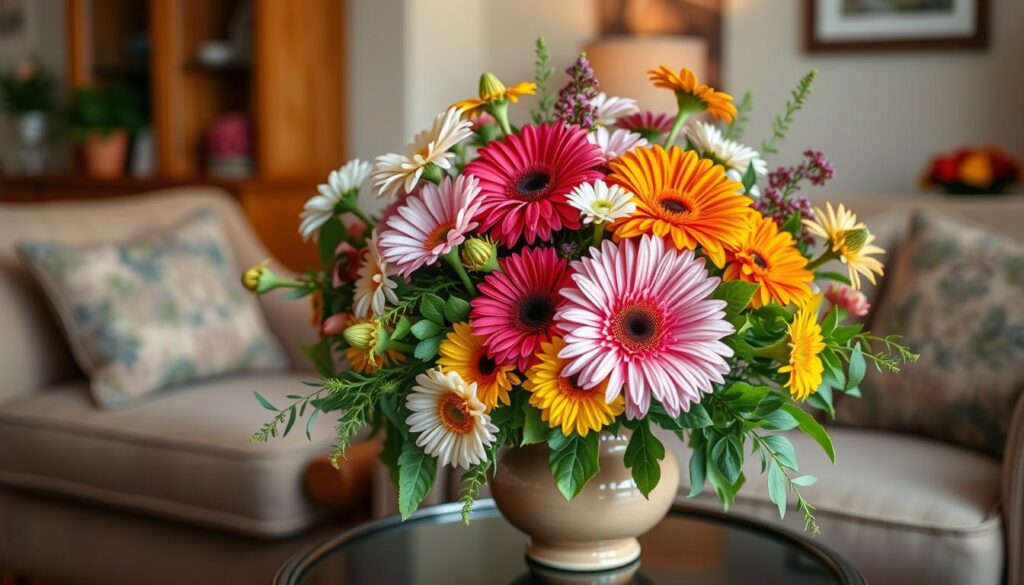
Alternative Options for Plant Decor
For senior living communities that prefer low-maintenance alternatives to live plants, there are several options to consider. Fake plants can provide the visual appeal of greenery without the need for watering or care, making them a hassle-free choice. Outdoor gardens, on the other hand, can be a collaborative community project that engages seniors and provides them with a connection to nature. These alternative plant decor solutions offer flexibility and convenience in senior living environments.
Fake Plants: Maintenance-Free Beauty
Artificial plants have come a long way in recent years, offering a realistic and sustainable indoor gardens option for senior living spaces. These maintenance-free greenery pieces can add a touch of nature without the worry of keeping live plants thriving. Fake plants come in a wide range of styles, from lush trailing vines to vibrant flowers, making it easy to find options that complement the durable greenery for assisted living decor. With no watering or pruning required, fake plants can provide a long-lasting, easy-care plants for senior homes solution for senior living communities.
Outdoor Gardens: A Community Project
Embracing the outdoors can be a rewarding experience for seniors. Establishing an outdoor garden within the senior living community can be a collaborative project that engages residents and promotes a connection to nature. By working together to plan, plant, and maintain the garden, seniors can enjoy the therapeutic benefits of gardening while fostering a sense of community. These outdoor green spaces can feature a variety of low-maintenance plants that thrive in the local climate, providing visual interest and a sustainable source of durable greenery for assisted living throughout the year.
“Homes decorated with plants have been shown to have a positive effect on physical and mental well-being.”
Proper Plant Placement and Maintenance Tips
To ensure the longevity and health of long-lasting plants for care facilities, hardy indoor flora for aging adults, and durable greenery for assisted living, it’s crucial to consider factors such as sunlight requirements, soil conditions, watering needs, and pruning routines. Proper placement of plants in areas with the appropriate light levels and well-draining soil can significantly improve their chances of thriving.
Sunlight and Soil Requirements
When choosing plants for senior living spaces, it’s essential to assess the available sunlight conditions. Some plants, like the Ponytail Palm, thrive in sunny areas, while others, such as the Spider Plant, prefer lower-light environments. Selecting the right plant for the right spot can make all the difference in their long-term success.
Similarly, the soil quality and drainage capabilities of the planting area should be considered. Jade Plants, for instance, require well-draining soil to prevent root rot, while Aglaonema (Chinese Evergreen) can tolerate slightly moist conditions. Ensuring the appropriate soil mix and drainage solutions can help maintain the health and vitality of these hardy indoor flora for aging adults.
Watering and Pruning Routines
Establishing a simple watering schedule is key to keeping long-lasting plants for care facilities happy and thriving. Overwatering can be just as detrimental as underwatering, so it’s important to find the right balance. Additionally, occasional pruning can help maintain the plants’ appearance and vitality, making them a low-maintenance addition to senior living environments.
By considering these essential factors, seniors and their caregivers can confidently incorporate durable greenery for assisted living into their spaces, creating a soothing and rejuvenating atmosphere for all to enjoy.
easy-care plants for senior homes: A Comprehensive Guide
For seniors living in assisted living communities or retirement homes, maintaining a lush, vibrant indoor garden can be a delightful and therapeutic experience. This comprehensive guide explores a diverse selection of low-maintenance houseplants that are well-suited for senior living greenery and retirement home botanicals. From trailing resilient foliage for elderly to hardy indoor flora for aging adults, these easy-care plants for senior homes can enhance the ambiance of senior living spaces while requiring minimal effort to maintain.
One of the key benefits of incorporating durable greenery for assisted living is the potential for sustainable indoor gardens that can thrive with little intervention. Many of the featured plants, such as the trailing pothos and the compact jade plant, possess the ability to adapt to low-light conditions and tolerate over or under-watering, making them ideal for seniors who may have limited time or physical capabilities for extensive plant care.
| Plant | Light Requirements | Watering Needs |
|---|---|---|
| Pothos | Low to bright indirect light | Water when soil is partially dry |
| Aglaonema (Chinese Evergreen) | Medium to low light | Water when top inch of soil is dry |
| Ponytail Palm | Bright, direct light | Water when soil is mostly dry |
| Jade Plant | Bright, direct light | Water when soil is dry to the touch |
| Spider Plant | Bright, indirect light | Water when top inch of soil is dry |
By carefully selecting long-lasting plants for care facilities that thrive on minimal care, seniors and their caregivers can enjoy the numerous benefits of indoor greenery without the burden of high-maintenance gardening. This guide provides a valuable resource for those seeking to create hardy indoor flora for aging adults and durable greenery for assisted living environments.
Conclusion
In conclusion, selecting the right easy-care plants for senior homes can significantly improve the overall environment and well-being of residents. By incorporating low-maintenance houseplants that thrive in various lighting conditions and require minimal watering, seniors and their caregivers can enjoy the benefits of senior living greenery without the burden of extensive maintenance. From trailing vines to vibrant flowers, this guide has provided a comprehensive overview of the best plants to consider for enhancing retirement home botanicals with natural beauty and therapeutic qualities.
Incorporating sustainable indoor gardens into senior living spaces can offer a multitude of benefits, including lower blood pressure levels, improved bone health, enhanced physical fitness, and reduced risk of chronic diseases. Resilient foliage for elderly residents can also promote mental well-being, reduce stress, and provide a sense of accomplishment through caring for these hardy indoor plants. By selecting long-lasting plants for care facilities and utilizing ergonomic gardening tools, seniors can enjoy the therapeutic aspects of gardening while minimizing physical strain.
Whether it’s the air-purifying capabilities of hardy indoor flora for aging adults or the soothing presence of fragrant blooms, durable greenery for assisted living environments can create a comforting and rejuvenating atmosphere for residents. By prioritizing plant selections that cater to the unique needs and preferences of senior living communities, caregivers can enhance the overall quality of life and foster a thriving, sustainable indoor oasis for their residents to enjoy.
FAQ
What are the benefits of incorporating plants into senior living environments?
Incorporating plants into senior living spaces offers numerous benefits, such as improved mental health, reduced stress levels, and enhanced cognitive function.
What are the common challenges seniors face when caring for plants?
Seniors may face challenges in maintaining plants due to limited mobility, inconsistent watering schedules, and low-light conditions.
Why is the Pothos plant a good choice for senior living spaces?
The Pothos plant thrives in low-light conditions and can tolerate both over and under-watering, making it a low-maintenance option for senior living environments.
What are the advantages of the Aglaonema (Chinese Evergreen) for senior living spaces?
The Aglaonema can survive in a wide variety of conditions, including low-light levels and inconsistent watering schedules, making it a versatile and low-maintenance choice for senior living environments.
Why is the Ponytail Palm a good option for senior living spaces with sunny windows?
The Ponytail Palm’s unique appearance, drought-tolerant nature, and ability to thrive with proper care make it a well-suited low-maintenance option for senior living environments with access to sunny windows.
What makes the Jade plant a good choice for senior living spaces?
The Jade plant’s ability to store water in its bulbous leaves allows it to tolerate periods of drought and neglect, making it an ideal low-maintenance option for senior living environments.
Why is the Spider plant a great choice for senior living spaces?
The Spider plant thrives in low-light conditions and is known for its easy-care nature, making it a reliable option for seniors who may have limited time or mobility for plant maintenance.
What non-toxic plant options are suitable for senior living spaces?
The Christmas Cactus and Boston Fern are two non-toxic options that offer visual interest and thrive in the low-light and humidity conditions often found in senior living environments.
What scent-free flower choices are ideal for senior living environments?
Sunflowers and Dahlias are two vibrant, long-lasting flower choices that lack strong scents, making them ideal for senior living environments without causing any unwanted sensory discomfort.
What are some alternative plant decor solutions for senior living communities?
Fake plants and outdoor gardens are alternatives to live plants that can provide the visual appeal of greenery without the need for extensive care or maintenance in senior living environments.
What factors should be considered when maintaining plants in senior living spaces?
Proper placement of plants in areas with the appropriate light levels and well-draining soil, as well as establishing a simple watering schedule and occasional pruning, can help maintain the plants’ appearance and vitality in senior living environments.

